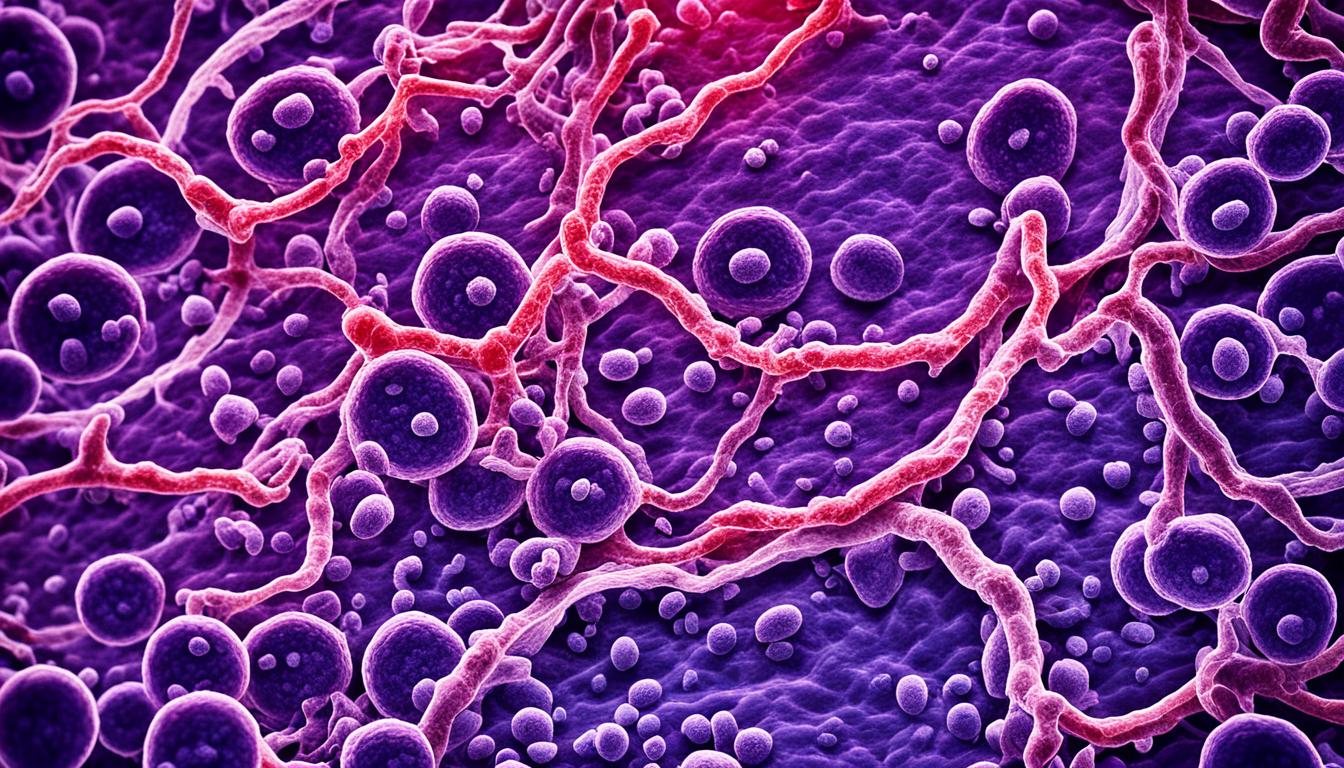Staph infections come from Staphylococcus aureus bacteria and can cause many symptoms. These can include a red, swollen, and painful area around the infection. You might also see boils or abscesses filled with pus. Sometimes, a staph infection brings on fever, chills, and makes you feel very tired.
Key Takeaways:
- Staph infections are caused by the bacteria Staphylococcus aureus.
- Symptoms of staph infection include redness, swelling, pain, and the formation of boils or abscesses.
- Other symptoms may include fever, chills, and fatigue.
- Prompt medical attention is important to prevent complications.
- Stem cell therapy is an emerging alternative treatment for staph infections.
Causes and Risk Factors of Staph Infection
Staph infections come from poor hygiene and surroundings. Not cleaning hands well is a key reason. Bacteria like Staphylococcus aureus can pass easily through touch. This shows why washing hands rightly is so crucial.
Being near someone with a staph infection is also risky. The bacteria spreads easily, even by touching someone else or surfaces they touched. So, keeping away from such people is vital to stop the infection.
Weak immune systems raise the chance of getting a staph infection. If you have health issues like diabetes or lung disease, you’re more likely to get sick. So, those with weak immune systems should be very careful.
Some diseases like diabetes make getting a staph infection more likely. These illnesses make our bodies less able to fight off the bacteria. Doctors must watch these patients closely to prevent staph infections from growing.
Risk Factors of Staph Infections
The main causes of staph infections are poor hand hygiene and being near someone infected. Factors that raise risk include weakened immune systems and some diseases. Knowing these, people can take steps to avoid staph infections and stay healthy.
Stem Cell Therapy for Staph Infections
For a long time, antibiotics were the top treatment for staph infections. Now, researchers are looking into other ways to help patients better. They’re finding that using stem cells may be very helpful. Stem cell therapy uses the powerhouse of stem cells to fix and renew damaged tissues. This new treatment method seems to work well for fighting infections.
Stem cells are special because they can change into many kinds of cells. This means they can be really great in medicine. In cases of staph infections, stem cell therapy helps the body heal itself from the bacterial infection. They do this by placing stem cells right into the area that’s hurting. This way, the body can work better to repair its tissues, lower swelling, and improve how it fights off infections.
Some studies have shown that stem cell therapy makes skin heal faster and wounds close quickly. This is crucial for fighting staph infections. Such exciting results hint that stem cells might be a way to help people with staph infections that are hard to treat.
Though we need more research to be sure of how well stem cell therapy works, the first signs are good. Mixing antibiotics with stem cell healing could offer a strong way to fight infections. By using both, experts hope to give patients more ways to get better.
As work on stem cell therapy’s benefits for staph infections goes on, we must remember that antibiotics are still key. But, adding stem cell therapy as an extra treatment option shows our ongoing push for better medical care. It’s all about improving how patients recover and their overall happiness.
Data regarding stem cell therapy in staph infection treatment:
| Study | Key Findings |
|---|---|
| Study 1 | Stem cell therapy enhanced wound healing and reduced infection severity in staph-infected mice. |
| Study 2 | Patients receiving stem cell therapy in addition to antibiotics experienced accelerated tissue regeneration and decreased hospitalization duration. |
| Study 3 | Stem cell therapy showed promising results in reducing antibiotic resistance in staph infections. |
Advantages of stem cell therapy for staph infections:
- Enhanced tissue repair and regeneration
- Reduced inflammation
- Boosted immune response
- Potential to address difficult-to-treat infections
Further study is vital, but the possible perks of stem cell therapy in fighting staph infections point to new medical horizons.
Conclusion
Staph infections, which come from Staphylococcus aureus bacteria, can make you very sick. It’s key to see a doctor quickly to avoid the infection from spreading. Also, this cuts down on possible health issues.
Doctors usually give antibiotics to beat staph infections. The antibiotic they pick depends on how bad the infection is and which type of staph is causing it. These drugs kill the bacteria and make you feel better. But you have to take them just as the doctor says. And, make sure to finish all the pills to fully get rid of the infection. This also helps to stop the bacteria from becoming resistant to antibiotics.
At times, regular treatments don’t work. That’s when doctors might try using stem cells to help. Studies suggest that stem cells can actually repair damaged parts of the body. Even though more research is necessary, this new way of treating staph infections shows a lot of promise.
It’s really important to know about the causes, signs, and how to treat Staphylococcus aureus infections. Doing so helps to stop the bacteria from spreading and hurting others. Just remember to keep clean, see a doctor when you don’t feel well, and take your medications like you’re supposed to. This is a good way to avoid getting sick from staph and staying healthy.

